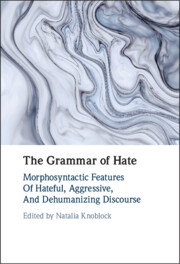Book contents
- The Grammar of Hate
- The Grammar of Hate
- Copyright page
- Contents
- Figures
- Tables
- Contributors
- Acknowledgments
- Introduction
- 1 Animacy and Countability of Slurs
- 2 Language Aggression in English Slang: The Case of the -o Suffix
- 3 Adj+ie/y Nominalizations in Contemporary English
- 4 Grammatical Gender and Offensiveness in Modern Greek Slang Vocabulary
- 5 Unseen Gender
- 6 The Neutering Neuter
- 7 Neutering Unpopular Politicians
- 8 The Power of a Pronoun
- 9 Is Play on Words Fair Play or Dirty Play?
- 10 Expressive German Adjective and Noun Compounds in Aggressive Discourse
- 11 ‘Kill the Invaders’
- 12 ‘I am no racist but …’
- 13 Homophobic Space–Times
- Index
- References
9 - Is Play on Words Fair Play or Dirty Play?
On Ill-Meaning Use of Morphological Blending
Published online by Cambridge University Press: 30 June 2022
- The Grammar of Hate
- The Grammar of Hate
- Copyright page
- Contents
- Figures
- Tables
- Contributors
- Acknowledgments
- Introduction
- 1 Animacy and Countability of Slurs
- 2 Language Aggression in English Slang: The Case of the -o Suffix
- 3 Adj+ie/y Nominalizations in Contemporary English
- 4 Grammatical Gender and Offensiveness in Modern Greek Slang Vocabulary
- 5 Unseen Gender
- 6 The Neutering Neuter
- 7 Neutering Unpopular Politicians
- 8 The Power of a Pronoun
- 9 Is Play on Words Fair Play or Dirty Play?
- 10 Expressive German Adjective and Noun Compounds in Aggressive Discourse
- 11 ‘Kill the Invaders’
- 12 ‘I am no racist but …’
- 13 Homophobic Space–Times
- Index
- References
Summary
Lexical blends such as Brexit < Britain + exit have been referred to in literature as instances of word play. The playful character of blends underlie their use in such domains as slang, advertising and political media. As has been shown, blending a personal name with a common noun, e.g. Haputin < hapat’ (grab) + Putin goes along with a variety of derogatory language means. Building on the findings in Beliaeva and Knoblock (2020), this study investigates factors that may trigger the use of lexical blending as verbal aggression and aims to explore derogatory meanings of blends referring to people. It is hypothesized that blending a personal name with another word enhances the likelihood of inducing derogatory meaning. Sample texts containing blends are extracted from the Now corpus and the iWeb corpus and analysed for the presence of emotionally coloured lexical elements. The results of the study suggest that the context of blends differs from the context of their non-blended counterparts, and reveal specific features in the use of blended words with human referents.
- Type
- Chapter
- Information
- The Grammar of HateMorphosyntactic Features of Hateful, Aggressive, and Dehumanizing Discourse, pp. 177 - 196Publisher: Cambridge University PressPrint publication year: 2022
References
- 1
- Cited by



